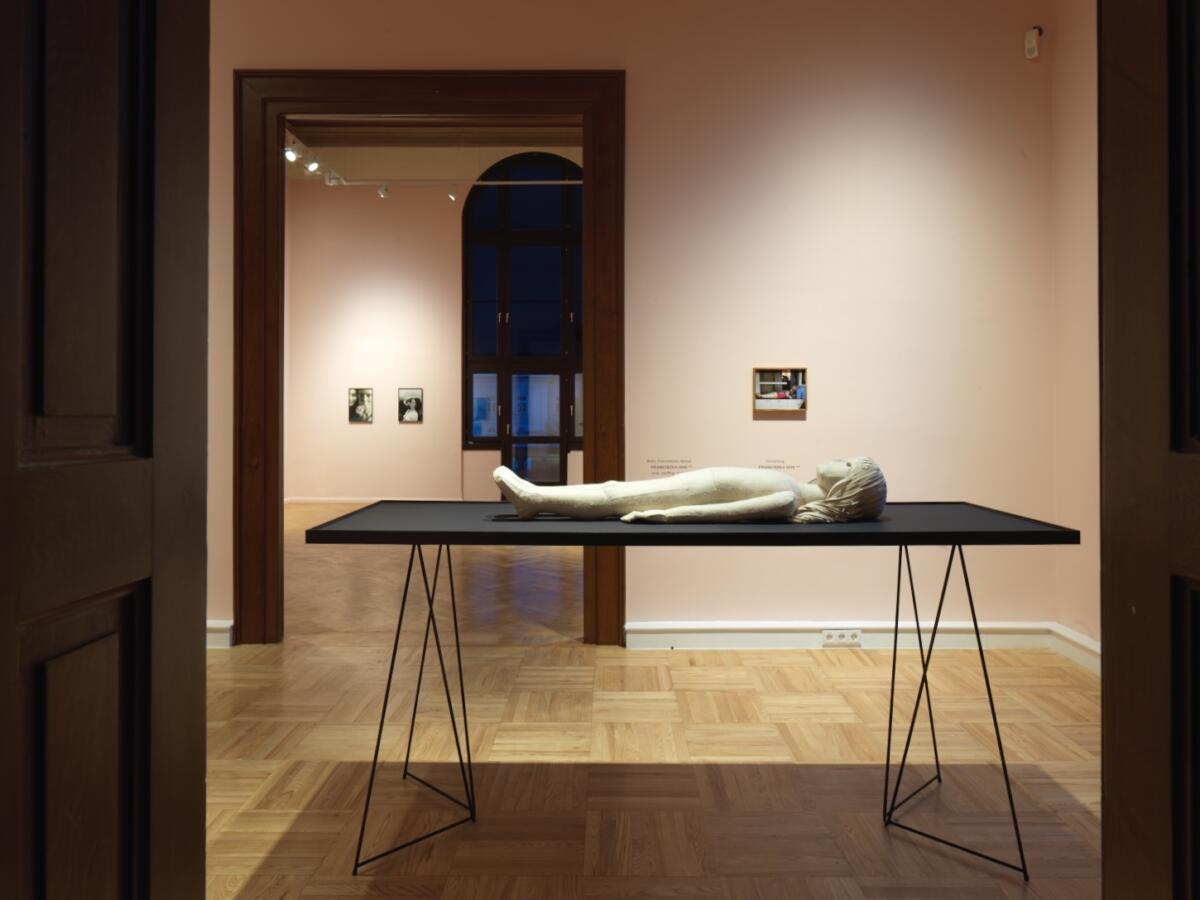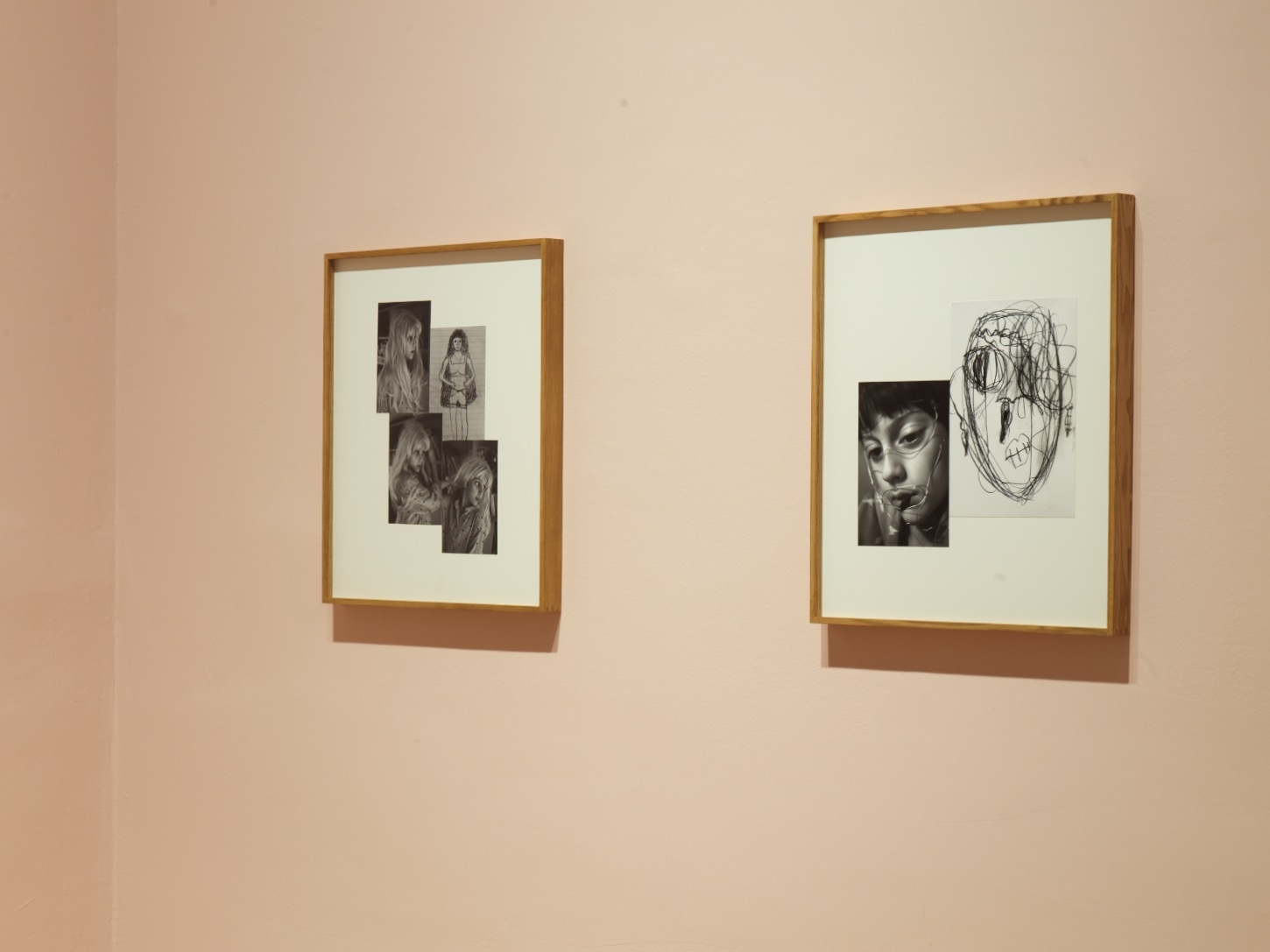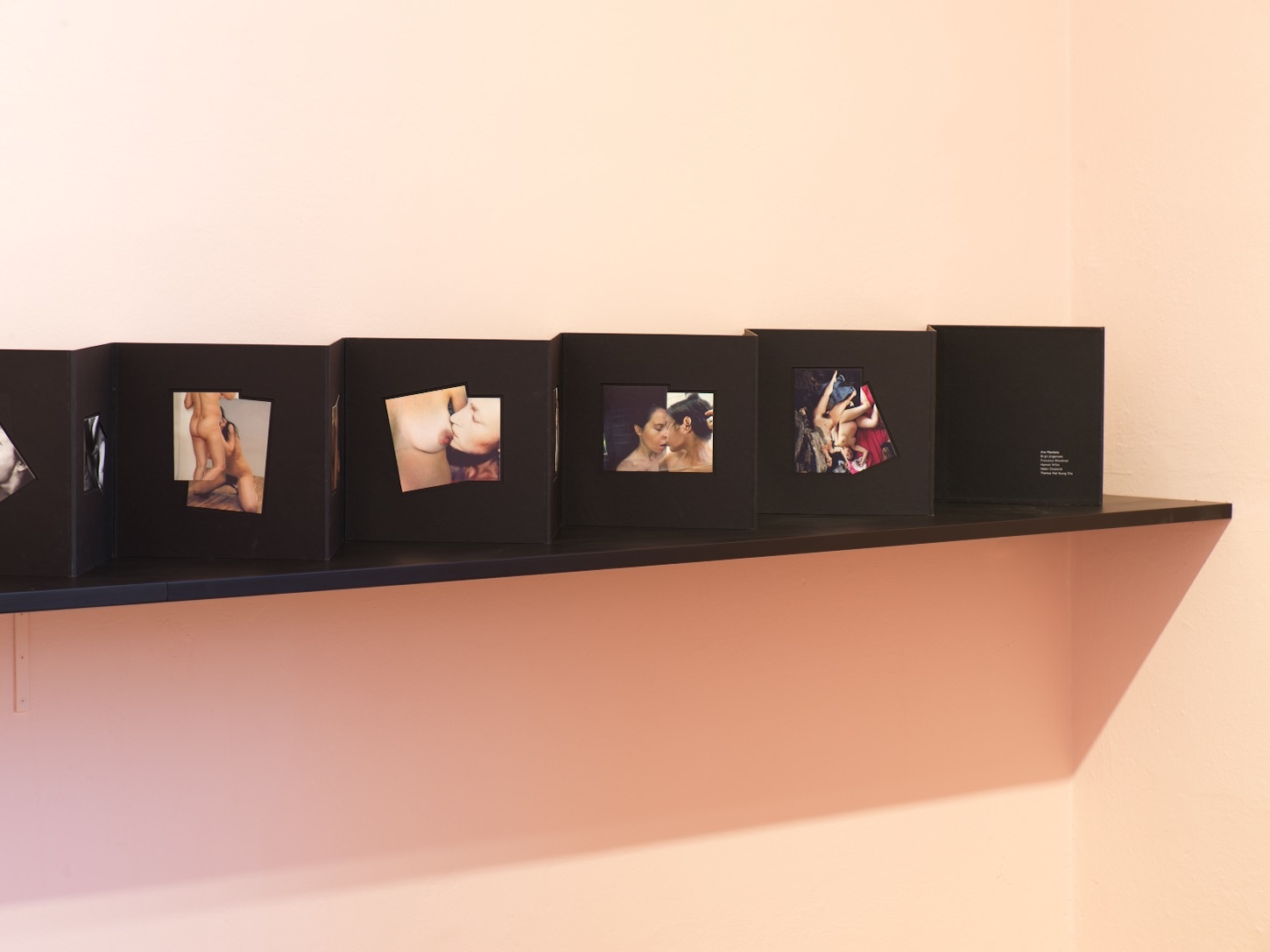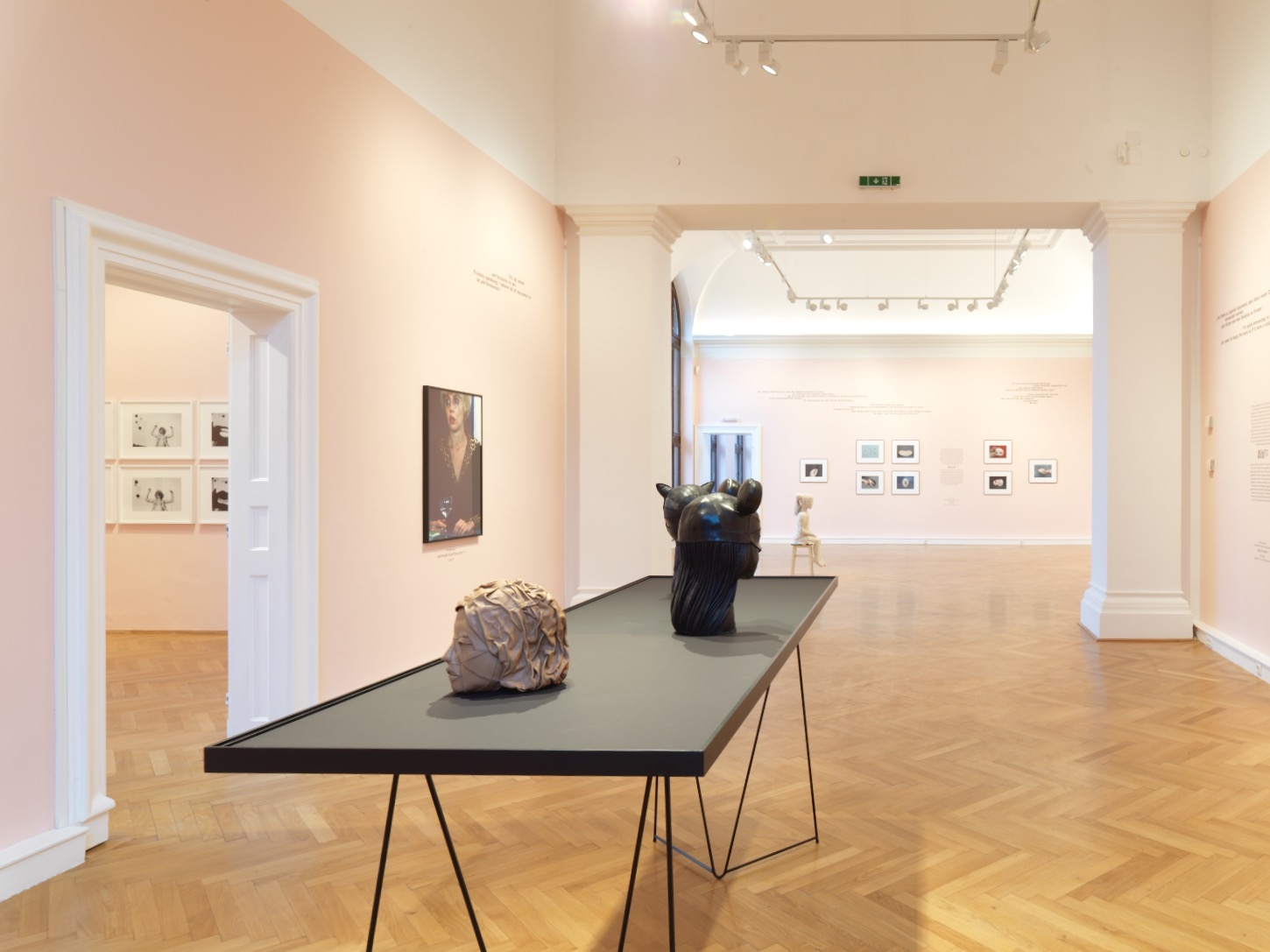
Email conversation between Rainald Schumacher and Aneta Grzeszykowska in autumn and winter 2020
I want to try to advance right into the exciting centre of your artistic work. Obviously, the work is about something as fuzzy as existence: to be here, to be a person, in a certain form or outer shell. In many of your pictures, you slip into such wrappings, pieces of clothing, disguises, or make up. Your photographs are documents of such moments ‘here and now’ that show yourself. Now, I am as such. These are not snapshots, but sophisticatedly arranged images. What kind of existence is taking place in the photographs? Is that you, or which parts and aspects are those stemming from you?
Theoretically, in my work, I develop a specific idea of departing from my own body and thus – existence. They both were replaced by Cindy Sherman, dead animals, pictures of me painted on my body, a doppelganger, a doll… Today, I am in a phase, where my body is replaced with the body of my daughter.
However, this departure from my own existence also occurs on a completely fundamental level in my work – in fact, I am not the subject of my work. My individual identity and my existing or replaced body become just an example, by which I try to analyse more universal ideas. In this sense, my body, identity, and existence are just material for work.
Can you define some of such universal ideas?
I mean my body, identity, and experiences are just exemplary, ordinary, and transparent, so that other people can easily identify with emotions generated in my work.
A few masks made of leather occasionally appear in your work. Are these masks different from fetish objects?
They are without doubt formally similar because, like fetishes, they are made of leather. However, in this case of my works, this leather has a different meaning. It is still a skin for me – previously converted into clothes that I retransform into what it was – the body. I tried to analyse this topic in Selfie, which also presents objects made of skin. But this skin is in this case in three different stages: alive – these are my hands; dead – the sculptures; the dead object – just backgrounds.

Aneta Grzeszykowska, ‘Family Skin’, exhibition view, photo: Michael Maritsch
Beauty Mask also has some strange fetish appearance. It’s always you, wearing these masks. Most of them severely deform the face, the mouth, the lips, cheeks, and chin. The series also has this performative quality.
The Beauty Mask series shows me posing with the masks bought in regular shops – masks which people use to make themselves beautiful. It’s quite interesting for me that these real objects shape the body as if it was a sculpture. People shape their bodies to make them ideal and beautiful as if they were contemporary artists. Of course, this aspect is full of violence and leads to associations with extreme sexual practices, martial arts, and criminal camouflage. Interestingyl, these procedures are not new. In the book Hygiene of the Face and Cosmetic Guide[1] by Richard W. Müller from the late 19th century, we can find similar examples of face masks used to preserve the beauty of the face.
These masks are also like costumes, which I wore to change my identity. My body is only visible through the holes for breathing and seeing. The most interesting part, in my opinion, is what remains hidden – a deformed face.
Years later, you somehow returned to the theme of deformation. What you did with your face with tapes and strings in Face Book seems more like a personal torture.
Face Book is a kind of another step of showing what was hidden in Beauty Mask.
Photo diptychs present characteristic ‘emotional types’ of the face, like a book faces. In fact, it refers to 19th- and 20th-century photographs documenting psycho-physiological experiments on the human body and the drastic portraits from medical archives presenting early attempts at plastic surgery, carried out for example on battle veterans. Emotions are a kind of masks I put on. Even if I change the position of my head, the emotion stays the same. It was interesting for me to carve something as elusive as a frown on my face. Something that is difficult to grasp with a regular photo, was attached to the face in this series and allowed for unlimited shooting time.
Already in 2005, you’ve created fifteen portraits of non-existing people, only with digital tools. Something that has become a common practice for enhancing and pimping up its own appearance in social media. You are directly referring in some titles of your series directly to social media: Face Book, Selfie. Is there a strategy behind it? Do you want to comment on such tools of our daily exchange of photographic images?
I have the feeling that some words, like ‘face’ and ‘book’, were somehow stolen from our language. It is, as if these emotions have been stolen as well. So, let’s say, my series is just the book of the faces, and Selfie is just the series of auto-portraits.

Aneta Grzeszykowska, ‘Family Skin’, exhibition view, photo: Michael Maritsch
As you mention Cindy Sherman: we’re talking about her iconic Untitled Film Stills from 1977 to 1980. You have ‘re-staged’ all 70 black and white motives of this series in 2006 in colour. How long did it take for you to stage these scenes and to slip into the 70 different female roles and imaginative identities? Did you only act and pose for the camera or did you use these layers for different women also in your ‘real’ life?
It took me almost a year of work, but I wasn’t in a hurry. My existential motivation, which I mentioned previously, is quite visible in this series. My point was not so much to play the roles, as in the case of the original, but to remove my person, body, and, above all, artistic identity. In the case of the concept of a work of art this seems to be a kind of artistic suicide. Paradoxically, Cindy Sherman, who turned into the different roles in her own work, becomes herself again in mine, although this time her body that is replaced with mine actually disappears. And she starts to play the only role – the famous artist.
Using the example of this work, you can clearly see the function of my body and identity that I mentioned – they are a transparent medium. The subject of playing various female roles was secondary to me and not really interesting. I was also interested in whether giving up my own artistic ego could be an act of self-centeredness.
You’re saying ‘remove my person, body and artistic identity’. Is there something similar taking place in the Halina series? And who is or was Halina?
Some time ago, at the request of the Archaeology of Photography Foundation[2], I worked with the archive of Wojciech Zamezcnik[3], who, apart from being a poster artist, had photographed a lot. In the extensive archive of his family, I found eleven photos that he took of his wife. They are very specific; they represent some random parts of her body. There were probably photos that he could use for production of posters. I expanded the frame of the photographs by placing my own body under the fragments of hers. And, because I was taking these pictures myself, holding the camera remote trigger, it looks, as if she – Halina Zamecznik – was the author of these photos.
So, yes, there is a reversal of the artist-model hierarchy and thus the artistic identity here. What I was particularly interested in, is the fact that, paradoxically, it is me – physically invisible in these photos – who takes over the authorship, becoming the author and model at the same time.

Aneta Grzeszykowska, ‘Family Skin’, exhibition view, photo: Michael Maritsch
Let’s focus on Love Book. At a first superficial glance, these are quite erotic and sexualised collages of two women. Looking at the imprint of the folding book, we can find a kind of who’s who of classical feminist art: Helen Chadwick, Theresa Hak, Kyung Cha, Birgit Jürgenssen, Ana Mendieta, Hannah Wilke, and Francesca Woodman. How do you interpret these collages?
I’m interested in dead female artists. More precisely, what’s left of them: images separated from the body. Death is a taboo for us. We displace it from our consciousness, but that does not alter the fact that we remain fascinated with it, which can be seen especially in the case of dead artists.
In Love Book I place my own body – or rather its images – next to the bodies of female artists in a specific relationship of love and violence. All the female artists I have mentioned in this work used a naked body to express themselves on feminist issues. And I am perpetrating a kind of rape on them. Physical rape, which is expressed in the image of ‘love’; and ideological rape, because they used their bodies for an entirely different purpose. In contrast, I objectify them in a way. But that does not alter the fact that my gesture is also a feminist act. However, the action here is perverse and radical.
It may be possible to say, a person, in some photography ‘exists’, at least ‘has existed’ in this photographic moment. Let’s ignore the questions of analogue, digital, or virtual manipulation. How would you describe such form of ‘being’ or ‘existence’ in a photography?
I think the image of the person in the photographs is the kind of mirror that reflects our emotions. I was trying to focus on this subject in the series Untitled (model) and Mama, by photographing the hyper-realistic sculpture of me, which was, in fact, a dead thing. People watching these series personified this object, bringing it to life with their own emotions.
So, in fact, it is us, who exist in the photographs, by watching photographed people. Of course, this has a special meaning today, when the image is more ‘real’ than reality, and our emotional existence and that of others is often limited to the image.
This is exactly what you had made for the Untitled (model) and the whole Mama series: a life-size model of your head and upper body. This body double is painted, made up, and equipped with artificial eyes, eyelashes, and hair. The eye of the camera and the way you photographed it, transform the artificial, dead object into something real. It is real to the eye of the beholder. It looks almost real, and since it is a human body, it could be alive or could have been alive.
‘It’s only a movie, or a photograph’, such a comment during a film full of fear, panic and suspense, does not change this frightful feeling and emotion. Are you playing consciously with such a cinematic, magic tricks?
Yes, of course. I’ve always wanted to be a director, and finally, I think I am. My artistic practice is to direct my own life for the needs of work and vice versa. The doll is a phantom on which everything can be safely tested. It enables to experience a kind of catharsis. My works are a bit like tragicomedies, with terrible and comic elements, just like life.

Aneta Grzeszykowska, ‘Family Skin’, exhibition view, photo: Michael Maritsch
The title of your exhibition is Family Skin. When you proposed the title at an early stage of the exhibition planning, I imagined some complex story about some kind of shell or cover for this construct of ‘family’. But foremost, you had in mind the reference to beauty and skin care products?
Family Skin refers to a strange, cosmetic expression ‘Family Skin Care’.
What I find interesting – by removing the word ‘care’, we obtain an expression analogous to the existing one – is ‘family blood’. In this context, I believe that Family Skin is more related to the surface, which in turn is more about representation.
I think, it combines all the subjects of the exhibition visible in my series Selfie, Beauty Mask, Mama etc.
In 2011, your daughter Franciszka was born. In the same year, I believe, you realized one of the first sculptures. It shows a life-size doll made from wool wearing some kind of mouse costume. The sculpture is named after your daughter, including the year 2014. What was going on in your mind working on this piece?
In the beginning, the dolls were made of black wool and featured me in the past. Then our daughter Franciszka was born. I started sewing dolls that depict her, but in the future – white. I really wanted to sew her, and she hadn’t grown up yet, I had no memories about her, only my imaginations. So, I concluded that I would be sewing these imaginations. Each of the white dolls is and will be completed by a photographic equivalent of Franciszka, when she reaches a particular age. It was interesting for me to reverse the order – art is a prototype of reality here, not the other way around. It is a story about our expectations; about how we shape our children, even if we don’t want to.
Mama, the series, is also reversing the order. The child is playing with a doll, which is not a baby-doll, but, instead her own ‘Mama’. From an outside perspective, as a naive ‘children psychologist’, it can also seem awful and irresponsible what you do with your child. It plays with a kind of corpse-doll. At the same time, it looks very innocent and happy the way your daughter handles this torso.
You’ve mentioned in the beginning some important shift in your work. ‘Today, I am at the stage, when my body is replaced with the body of my daughter.’ There are three new collages in the exhibition. These were added to offer a glimpse into the possible future of your work. They are from a new series Funny’s Book, showing photographs of your daughter, playing with wigs, clothes, collaged together with photographs of drawings. I guess, these are also of your daughter. You told me you’ve spent a longer time during the ‘shut down’ in the countryside. Did the eye of your camera explore your daughter, not only as a daughter, a young girl but as an artistic subject matter? Has your daughter’s body, photographed, a similar role as your own body had in your earlier series, or, what is the difference?
In KwieKulik’s[4] classic cycle Activities with Dobromierz[5] (1972–74), the artists, just after their son Maksymilian Dobromierz was born, started to ‘use their child in their art’. The artists’ son appears alongside various household objects while the artists tried to practically study the supposed subject / object polarity in the artistic experience. When photographing my daughter, I make her the subject. Franciszka is an active participant here and a creator of events. I reverse roles between mother and daughter, child and adult, artist and model. By transgressing the generally accepted convention, I cast my daughter as the causative agent. Franciszka is the person who sets the tone for what is happening, taking the reins and reversing the generally accepted balance of power. I look at this situation a bit like a director. Observing a certain situation unfolding nearby, I choose the right means to tell the story. And in a way, yes – she replaces me because she is in the pictures instead of me. But that is not a purpose in itself. Instead, it is due to the fact that at work, I always do what I am absolutely interested in. And I just lost interest in myself, but not in my own daughter.

Aneta Grzeszykowska, ‘Family Skin’, exhibition view, photo: Michael Maritsch
This text first appeared in a catalogue published as part of the exhibition Aneta Grzeszykowska – Family Skin held at Francisco Carolinum Linz from October 28th until April 5th 2021, curated by Rainald Schumacher und Nathalie Hoyos.
[1] Müller, Richard W.: Hygiene of the Face and Cosmetic Guide, 1850 -, Reprint, Wentworth Pr., 2016
[2] Fundacja Archeologia Fotografii in Warsaw was founded in 2008. The foundation is focused on archiving, documenting and mediating mostly private Polish photoarchives. https://faf.org.pl (retrieved 01.2021)
[3] Wojciech Zamecznik (1923–1967) was an important member of the Polish School of Poster, which gained international recognition in the 1960s and 1970s.
[4] KwieKulik were active as an artist couple between 1971 and 1987. The artist duo of Przemyslaw Kwiek (*1945) und Zofia Kulik (*1947) were important players in the Polish art scene.
[5] In between 1972 and 1974 the artist duo KwieKulik produced nearly 900 photographs (colour dia slides and black and white negatives) featuring their young son in arranged settings.
Imprint
| Artist | Aneta Grzeszykowska |
| Exhibition | Family Skin |
| Place / venue | Francisco Carolinum, Linz, Austria |
| Dates | 28 October 2020 – 05 April 2021 |
| Curated by | Nathalie Hoyos and Rainald Schumacher |
| Website | www.ooelkg.at/en/location/landesgalerie-linz.html |
| Index | Aneta Grzeszykowska Francisco Carolinum Rainald Schumacher |
